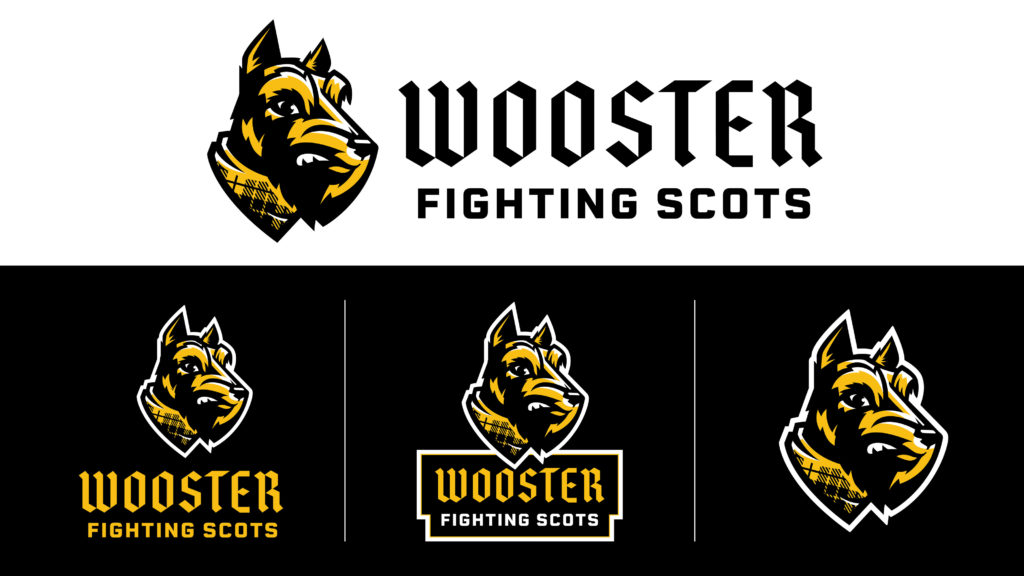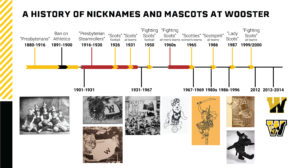Frequently Asked Questions Our History of Scottie Dogs Naming the Fighting Scots Mascot
Determined, fierce, kind, hardworking, intelligent, inclusive—These are just a few of the words Wooster students use to describe what it means to be Fighting Scots.
In a world where opportunity is not distributed equally, creating a diverse, equitable, welcoming, and inclusive campus community must be a top priority. We are not able to achieve this priority without also examining the most visible symbols we use as a campus to reflect our values, character, and culture. This includes our school mascot.
Because no single human can attempt to represent all the diverse identities of our thriving Wooster community, The College of Wooster on March 30, 2023, introduced an updated mascot that reflects the inclusive community we aim to create while also paying homage to our storied history and heritage.
The Scottie dog has served as a source of pride for generations of Fighting Scots beginning with our earliest days of existence and will be sure to do the same for generations to come.
The updated mascot reflects the collaborative efforts of students, staff and alumni, who generated ideas, gave of their time to help with the research efforts, design, launch events, and provided input along the way.
New Scottie dog costumes arrive on campus this summer in time to recruit and train a new roster of student mascot performers who will work to entertain crowds at home games, admissions and alumni events, and engagements across the local community. The costumes will include MacLeod plaid kerchiefs and matching kilts, along with a black belt and sporran, which is a traditional part of the Pipe Band’s uniform.

Wooster Community Members Name Mascot
Frequently Asked Questions
Mascot
Yes! We are the Fighting Scots. Rather than representing the Fighting Scots with the Scottish Highlander, we will now use a Scottish Terrier, otherwise known as a Scottie dog.
As we examine Wooster’s history, the Scottie dog was the first mascot at Wooster and has never really gone away even with the introduction of the Scottish Highlander fighter in the late 60s, early 70s. Up through today, the Scottie is widely accepted as one of Wooster’s mascots.
More importantly, however, no human mascot can represent all the diverse identities of our campus community and many human mascots raise serious concerns about racism, xenophobia, and are otherwise problematic. The introduction in recent years of the Washington Commanders and Cleveland Guardians are two examples of professional sports teams who recognized the harm caused by human mascots. There are many more examples at the collegiate level, including Kenyon College, who changed from Lords and Ladies to Owls, and Capital University, who changed from Crusaders to Comets.
A symbol of European imperial expansion, the Scottish Highlander fighter no longer represents the current and future Wooster.
Results from a survey of students showed a majority of student respondents did not relate to the Scottish Highlander mascot. The reasons they provided included: “he looks white,” “he looks like a man,” “doesn’t represent the values of the college,” “needs to be more inclusive,” “represents violence,” “represents colonialism,” and “needs to be more inclusive.”
According to student respondents, Wooster Fighting Scots must represent community, be determined, hardworking, strong, kind, smart, resilient, intelligent, passionate, perseverant, and inclusive.
The new Scottie dog logo made its debut on campus on Thursday, March 30, 2023, during a pep rally in Timken Gymnasium. This summer it will be added to wind screens on our new tennis courts on Wayne Avenue and to the gymnasiums. We will begin to form a planning committee soon who will identify opportunities to introduce the new Scottie dog logo throughout Scot Center. Please visit Mayer Bookstore online or in the lower level of Lowry Center to grab some Scottie dog merchandise.
The College will be working throughout the next year to replace old logos with the new logo. In so doing, we will make every effort to save historical pieces for the archives.
Numerous informal discussions have been held over the years about the mascot. We even held a First-Year Seminar class in Fall 2019 on the Fighting Scots as a historical concept and asked students to think critically about what it meant to have the Highlander with shield and sword as our mascot.
In 2021, we introduced new institutional and athletic logos that removed the Highlander from the W and replaced it with a custom W that was designed to pull from the deconstructed pattern of the MacLeod plaid. A special working group of staff in athletics and marketing was meeting to consider options for moving beyond the Highlander that was introduced to campus in the spring of 1973. The group’s work centered on addressing concerns raised by students and others about the lack of inclusivity of the Highlander, while creating a mascot that stayed true to the Wooster brand and the College’s history.
Research was conducted to learn more about the history of mascots and nicknames at the College, and students were surveyed about their thoughts regarding the mascot and the qualities and characteristics that come to mind when they think of Wooster Fighting Scots.
Historically, we’ve had few mascots but many nicknames. As we paged through old athletic programs and the archives, a few things were abundantly clear: Our unwavering affinity for the black & gold, loud MacLeod plaid, and Scottish Terriers.
We came across a lot of Scottish terriers during our review—real-life dogs posing for yearbook photos and wearing MacLeod sweaters, larger than life dogs on Homecoming floats and on the lawns of residence halls, dog illustrations that were on the front pages of athletic programs in the early 80s (a decade after the introduction of the warrior mascot), and dog mascot costumes that are worn during home contests up through today. It wasn’t until 2013-14, that we see broader adoption of the Highlander in College branding and throughout the Scot Center.
Results from our survey showed a majority of student respondents did not relate to the Highlander mascot. The reasons they provided include: “he looks white,” “he looks like a man,” “doesn’t represent the values of the college,” “needs to be more inclusive,” “represents violence,” “represents colonialism,” and “needs to be more inclusive.”
According to student respondents, Wooster Fighting Scots must represent community, be determined, hardworking, strong, kind, smart, resilient, intelligent, passionate, perseverant, and inclusive.
Slagle Design, a firm based in Columbus, Ohio, specializing in creating and updating mascots, led the design efforts with input from a working group of staff and coaches from athletics, marketing, students, and alumni.
The name for Wooster’s new Fighting Scots mascot is Archie.
Members of the campus community submitted nearly 800 suggestions for names for Wooster’s updated Fighting Scots mascot.
Staff collected those suggestions and developed a poll that allowed constituents to rank their favorite names among the top three suggestions: Archie, McWoo, and Mac. After four days of voting and nearly 1,500 responses from community members, Archie will be the name of the new Fighting Scots mascot.
Yes! Street Characters in Alberta, Canada, is designing and manufacturing the mascot costumes, which are scheduled to arrive on campus in June. We will be recruiting a roster of students to serve as mascot performers who will work to entertain crowds at home games, admissions and alumni events, and engagements across the local community. The costumes will include MacLeod plaid kerchiefs and matching kilts, along with a black belt and sporran, which is a traditional part of the Pipe Band’s uniform.
A history of Scottie dogs at Wooster
The earliest uses of a Scottie dog as a mascot at The College of Wooster reach as far back as the early 20th century. The term Scots has been used for nearly 100 years with the football team adopting the moniker in 1926, followed by the rest of the athletics teams in 1931.

